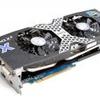Hardware setup | Power consumption
Hardware installation
Installation of any of the AMD Radeon cards is really easy. Once the card is seated into the PC make sure you hook up the monitor and of course any external power connectors like 6 and/or 8-pin PEG power connectors. Preferably get yourself a power supply that has these PCIe PEG connectors native (converting them from a Molex Peripheral connector anno 2012 we feel is a no-go).
Once done, we boot into Windows, install the latest ATI Catalyst drivers and after a reboot all should be working. No further configuration is required or needed unless you like to tweak the settings, for which you can open the Catalyst Control Center.

Power Consumption
Let's have a look at how much power draw we measure with this graphics card installed.
The methodology: We have a device constantly monitoring the power draw from the PC. We simply stress the GPU, not the processor. The before and after wattage will tell us roughly how much power a graphics card is consuming under load.
We decided to move away from Furmark as stress test in early 2011 and are now using a game like application which stresses the GPU yet is much more representable of power consumption and heat levels coming from the GPU. We however are not disclosing what application that is as we do not want AMD/ATI/NVIDIA to "optimize & monitor" our stress test whatsoever, for our objective reasons of course.
Our test system is based on a power hungry Core i7 965 / X58 system. This setup is overclocked to 3.75 GHz. Next to that we have energy saving functions disabled for this motherboard and processor (to ensure consistent benchmark results). On average we are using roughly 50 to 100 Watts more than a standard PC due to higher CPU clock settings, water-cooling, additional cold cathode lights etc.
We'll be calculating the GPU power consumption here, not the total PC power consumption.
Measured power consumption
- System in IDLE = 176W
- System Wattage with GPU in FULL Stress = 390W
- Difference (GPU load) = 214W
- Add average IDLE wattage ~10W
- Subjective obtained GPU power consumption = ~ 224 Watts
Mind you that the system wattage is measured at the wall socket.
We estimate and calculate here based on four hours of GPU intensive gaming per day for 5 days a week with this card.

Above, a chart of relative power consumption. Again the Wattage shown is the card with the GPU(s) stressed 100%, showing only the peak GPU power draw, not the power consumption of the entire PC and not the average gaming power consumption.
Here is Guru3D's power supply recommendation:
- Radeon HD 7970 - On your average system the card requires you to have a 550 Watt power supply unit.
- Radeon HD 7970 Crossfire - On your average system the cards require you to have a 750 Watt power supply unit as minimum.
If you are going to overclock GPU or processor, then we do recommend you purchase something with some more stamina.
There are many good PSUs out there, please do have a look at our many PSU reviews as we have loads of recommended PSUs for you to check out in there. What would happen if your PSU can't cope with the load.

